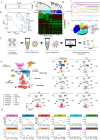Regulation of dynamic spatiotemporal inflammation by nanomaterials in spinal cord injury
- PMID: 39696584
- PMCID: PMC11657436
- DOI: 10.1186/s12951-024-03037-8
Regulation of dynamic spatiotemporal inflammation by nanomaterials in spinal cord injury
Abstract
Spinal cord injury (SCI) is a common clinical condition of the central nervous system that can lead to sensory and motor impairment below the injury level or permanent loss of function in severe cases. Dynamic spatiotemporal neuroinflammation is vital to neurological recovery, which is collectively constituted by the dynamic changes in a series of inflammatory cells, including microglia, neutrophils, and astrocytes, among others. Immunomodulatory nanomaterials can readily improve the therapeutic effects and simultaneously overcome various drawbacks associated with treatment, such as the off-target side effects and loss of bioactivity of immune agents during circulation. In this review, we discuss the role of dynamic spatiotemporal inflammation in secondary injuries after SCI, elaborate on the mechanism of action and effect of existing nanomaterials in treating SCI, and summarize the mechanism(s) whereby they regulate inflammation. Finally, the challenges and prospects associated with using nanotechnology to modulate immunotherapy are discussed to provide new insights for future treatment. Deciphering the intricate spatiotemporal mechanisms of neuroinflammation in SCI requires further in-depth studies. Therefore, SCI continues to represent a formidable challenge.
Keywords: Astrocyte; Inflammation; Microglia; Nanomaterials; Spatiotemporal dynamic; Spinal cord injury.
© 2024. The Author(s).
Conflict of interest statement
Declarations. Ethics approval and consent to participate: Not applicable. Consent for publication: Not applicable. Competing interests: The authors declare no competing interests.
Figures










Similar articles
-
Effects of astrocytes and microglia on neuroinflammation after spinal cord injury and related immunomodulatory strategies.Int Immunopharmacol. 2022 Jul;108:108754. doi: 10.1016/j.intimp.2022.108754. Epub 2022 Apr 6. Int Immunopharmacol. 2022. PMID: 35397392 Review.
-
Lentivirus-mediated downregulation of α-synuclein reduces neuroinflammation and promotes functional recovery in rats with spinal cord injury.J Neuroinflammation. 2019 Dec 30;16(1):283. doi: 10.1186/s12974-019-1658-2. J Neuroinflammation. 2019. PMID: 31888724 Free PMC article.
-
Research Progress on Treating Spinal Cord Injury by Modulating the Phenotype of Microglia.J Integr Neurosci. 2024 Sep 19;23(9):171. doi: 10.31083/j.jin2309171. J Integr Neurosci. 2024. PMID: 39344231 Review.
-
Impairment of autophagy after spinal cord injury potentiates neuroinflammation and motor function deficit in mice.Theranostics. 2022 Jul 11;12(12):5364-5388. doi: 10.7150/thno.72713. eCollection 2022. Theranostics. 2022. PMID: 35910787 Free PMC article.
-
The Role of Microglia in Modulating Neuroinflammation after Spinal Cord Injury.Int J Mol Sci. 2021 Sep 8;22(18):9706. doi: 10.3390/ijms22189706. Int J Mol Sci. 2021. PMID: 34575871 Free PMC article. Review.
Cited by
-
Exosomes: a promising microenvironment modulator for spinal cord injury treatment.Int J Biol Sci. 2025 Jun 5;21(8):3791-3824. doi: 10.7150/ijbs.115242. eCollection 2025. Int J Biol Sci. 2025. PMID: 40520019 Free PMC article. Review.
-
Antioxidant nanozymes: current status and future perspectives in spinal cord injury treatments.Theranostics. 2025 May 8;15(13):6146-6183. doi: 10.7150/thno.114836. eCollection 2025. Theranostics. 2025. PMID: 40521206 Free PMC article. Review.
-
Crosstalk between ferroptosis and endoplasmic reticulum stress: A potential target for ovarian cancer therapy (Review).Int J Mol Med. 2025 Jun;55(6):97. doi: 10.3892/ijmm.2025.5538. Epub 2025 May 2. Int J Mol Med. 2025. PMID: 40314096 Free PMC article. Review.
-
Nanoparticle-Driven Modulation of Mucosal Immunity and Interplay with the Microbiome.J Microbiol Biotechnol. 2025 Jun 12;35:e2404033. doi: 10.4014/jmb.2504.04033. J Microbiol Biotechnol. 2025. PMID: 40537897 Free PMC article. Review.
References
-
- Tamburin S, Filippetti M, Mantovani E, Smania N, Picelli A. Spasticity following brain and spinal cord injury: assessment and treatment. Curr Opin Neurol. 2022;35(6):728–40. - PubMed
-
- Alonso F, Hart DJ. Advanced imaging techniques in cervical spinal cord trauma. World Neurosurg. 2015;83(4):496–7. - PubMed
-
- Badhiwala JH, Wilson JR, Witiw CD, Harrop JS, Vaccaro AR, Aarabi B, et al. The influence of timing of surgical decompression for acute spinal cord injury: a pooled analysis of individual patient data. Lancet Neurol. 2021;20(2):117–26. - PubMed
Publication types
MeSH terms
Grants and funding
- 82401619/National Natural Science Foundation of China
- 51803072/National Natural Science Foundation of China
- 82271411/National Natural Science Foundation of China
- 2022qnpy11/Youth Support Programmed Project of China Japan Union Hospital of Jilin University
- 2022SCZ25/Department of Finance of Jilin Province
LinkOut - more resources
Full Text Sources
Medical

